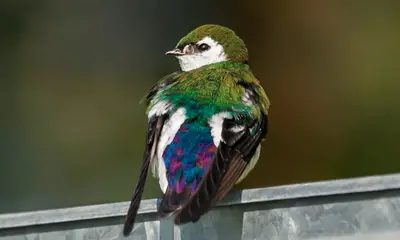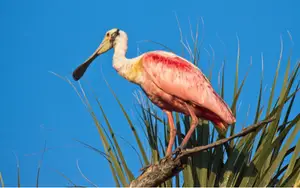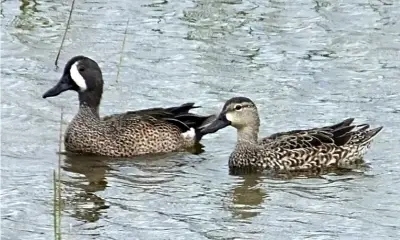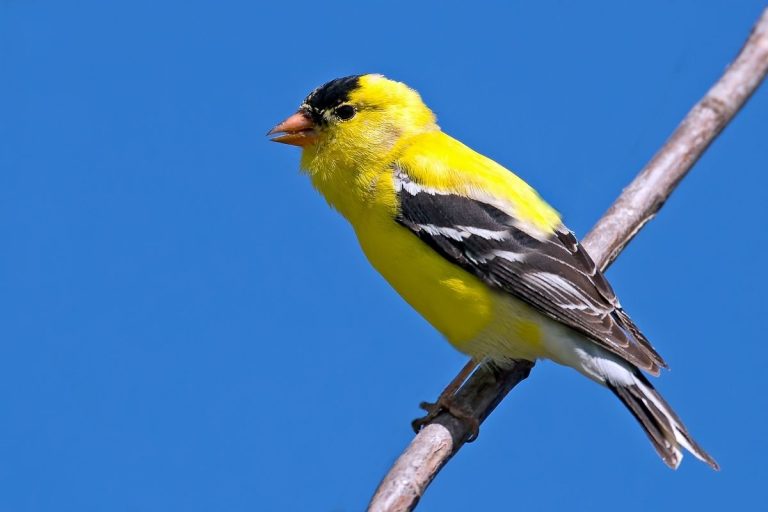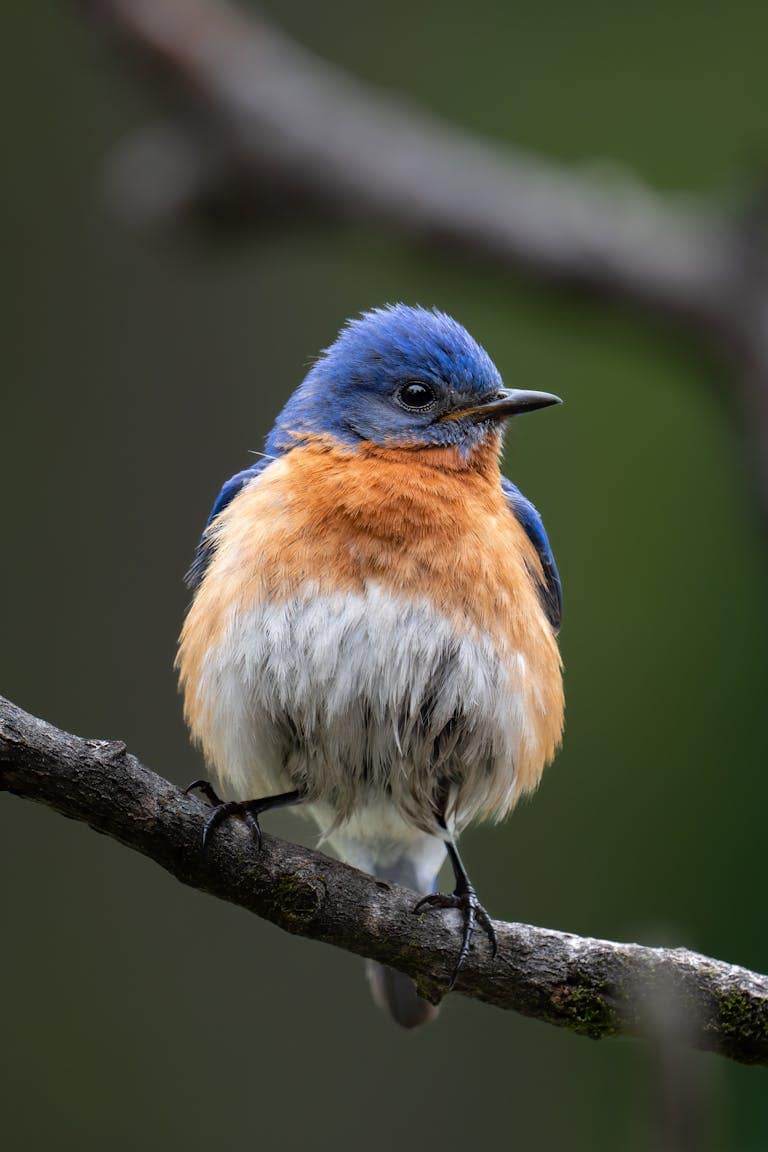21 Florida BIRDS With LONG BEAKS (ID Guide With Photos)
Did you recently spot a bird with a long beak in Florida? In that case you’ll probably want to know what species you saw.
Identifying long-beaked birds in Florida is not as easy as it might seem, since there are surprisingly many birds in the Sunshine State that fit this description.
To help you identify the bird you saw, we’ll cover the most important types of Florida birds with long beaks.

What types of Florida birds have long beaks?
There are 21 types of birds in Florida with long beaks, which are described in full detail below.
White Ibis
Scientific name: Eudocimus albus
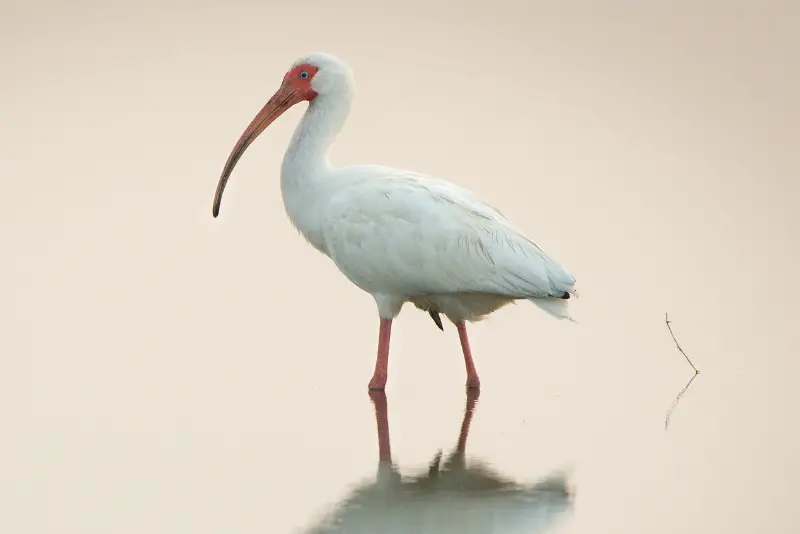
This white bird with a long beak is easy to recognize due to its birght white plumage and extremely long orange beak that is curved downwards.
But keep in mind that during the first two years of their lives, immature White Ibises have a chocolate brown body with light streaks and a pale orange beak.
While the White Ibis is most commonly found in coastal areas of Florida, it prefers to forage in freshwater habitats.
These Florida water birds feed on fish, insects, crayfish, and other crustaceans. They nest in large colonies in forests located close to wetlands.
White Ibises are extremely social birds, and like to forage in groups of 20 birds or more. In fact, it’s rare to see a solitary White Ibis.
Limpkin
Scientific name: Aramus guarauna
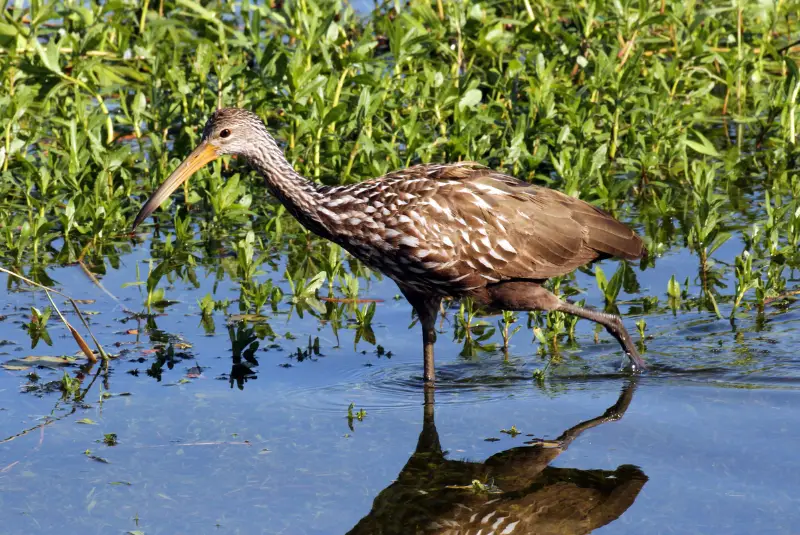
This large wading bird is a year-round resident throughout Florida, and can be encountered in a variety of wetland habitats.
Limpkins have a long thick beak, which they use to pry open the shells of mussels and other bivalves.
When they feel threatened or need to escape danger, they raise their head high into the air, creating the illusion of greater size and presence to deter predators.
Apart from their long bills, limpkins are known for their nocturnal calls, where they will cry out mournfully in the middle of the night.
Long-billed Dowitcher
Scientific name: Limnodromus scolopaceus

The Long-billed Dowitcher is very similar to the Short-billed Dowitcher, and indeed, the two species are sometimes observed together.
However, while the Short-billed Dowitcher is a breeding bird in Florida, the Long-billed Dowitcher breeds in the arctic Tundra, and is seen in the state of Florida only during the winter.
While it’s hard to distinguish between the two species, the Long-billed Dowitcher is slightly larger and has a longer bill.
These differences are most apparent if you see a mixed flock with both species of dowagers.
Long-billed Curlew
Scientific name: Numenius americanus
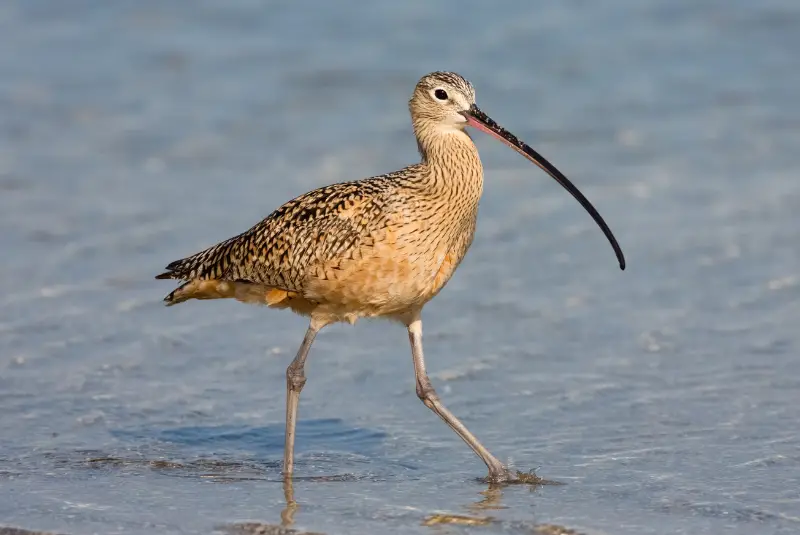
While the Long-billed Curlew is a breeding bird in the grasslands of the northwestern United States, it can be seen in Florida during winter from November through February.
This is the largest shorebird in Florida, and together with its extremely long, downturned beak, this makes it easy to identify when you see one.
Long-billed Curlews frequent mudflats, beaches, estuaries and flooded areas of Florida, where they use their long bill to probe the ground for worms and other invertebrates.
Black-necked Stilt
Scientific name: Himantopus mexicanus

This wading bird is easy to identify by its striking black-and-white plumage coupled with long reddish pink legs, and a long thin beak.
With long legs that are more than 9 inches long, the Black-necked Stilt has the longest legs of any bird in proportion to its body size.
This shorebird is a year-round resident in Florida. Its preferred breeding habitat are shallow marshes, but during the winter it is also found along the coast.
Willet
Scientific name: Tringa semipalmata
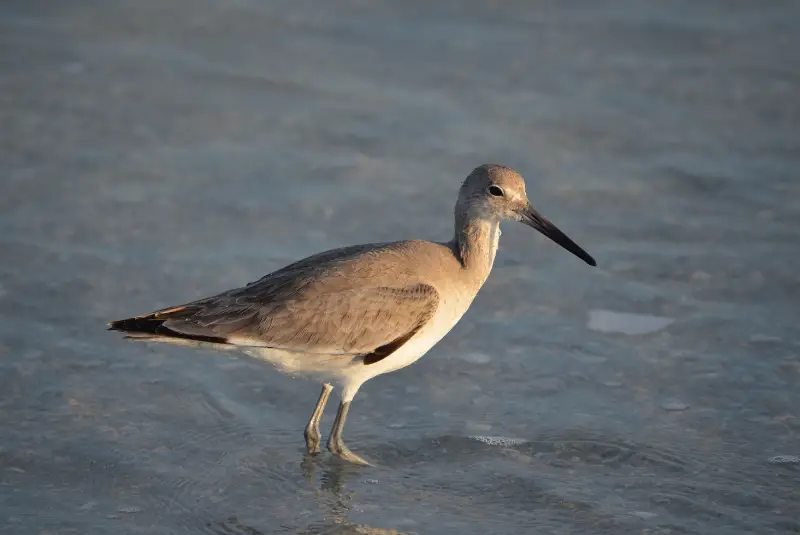
The Willet is common along the coast of Florida during the winter, but is also a year-round breeding bird in northern areas of Florida.
It is a medium sized wading bird with a brown upper side and a white underside. It is a beach bird that only occurs in saltwater habitats.
When it takes to the wing, its conspicuous black-and-white wing markings become visible. It forages for small aquatic insects, worms, crabs, and other invertebrates along the ocean shore.
Whimbrel
Scientific name: Numenius phaeopus
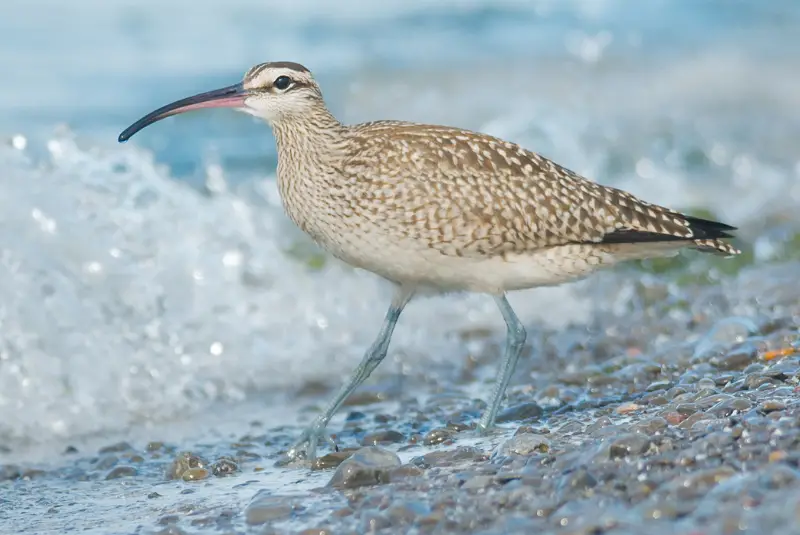
The Whimbrel is another large wading bird with a long downturned beak, and looks superficially similar to a Curlew, but is smaller than the latter and has a slightly shorter beak.
These birds breed in the arctic tundra, but can be observed along the Florida coast as rare winter visitors.
Whimbrels frequent mudflats, tidal estuaries, and saltmarshes, where their main food source consists of small crabs and other crustaceans.
American Oystercatcher
Scientific name: Haematopus palliatus
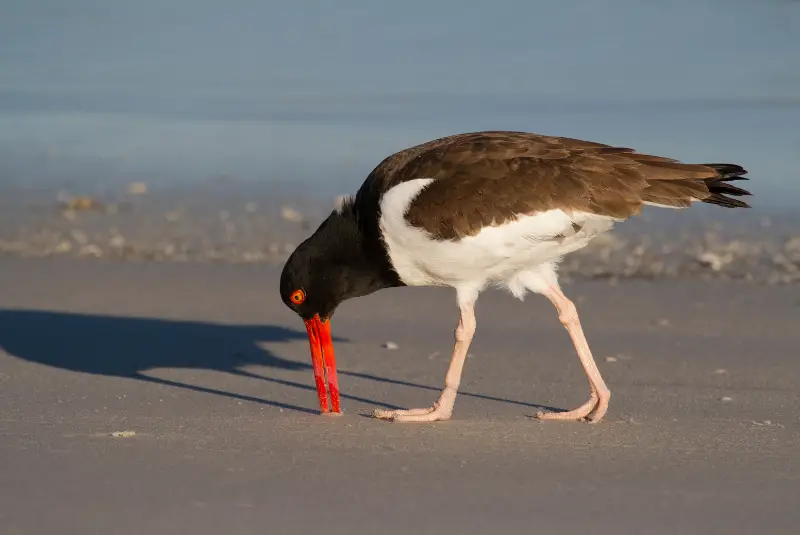
American Oystercatchers are beautiful beach birds with striking coloration. They have a jet black head and neck, which contrasts with a bright white belly and a long, heavy red bill.
The Oystercatcher is a bird of the tidal flats, where it follows the tidal patterns to feed on shellfish during low tide.
The heavy bill of the Oystercatcher helps it to pry open the shells of mollusks, and it also serves for hammering their shell until it shatters.
It is a year-round resident along the entire coast, inhabiting the tidal flats and beaches of Florida.
American Avocet
Scientific name: Recurvirostra americana
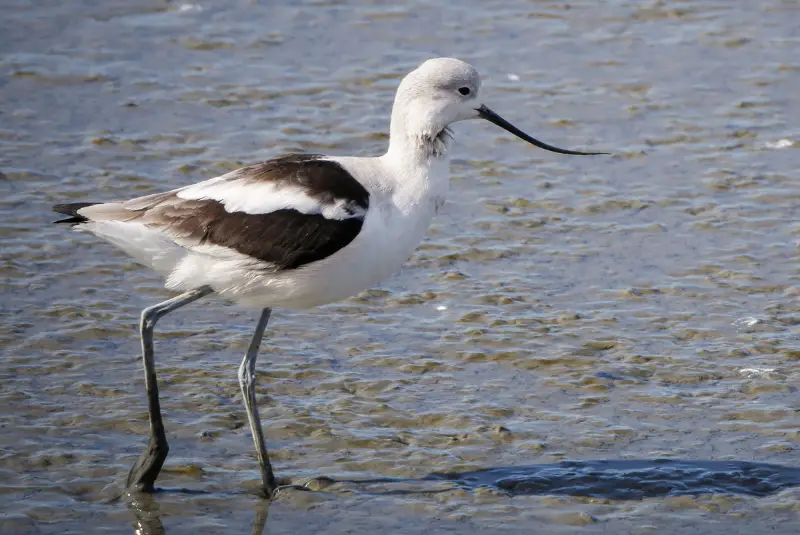
The American Avocet is another wading bird that doesn’t breed in Florida, but can be found wintering along the coast of Florida.
These elegant shore birds have a long bill that is unusual in that it is curved upwards, which makes it unique among all the birds on this list.
American Avocets are often encountered together with Black-necked Stilts at coastal lagoons and mudflats in Florida.
Roseate Spoonbill
Scientific name: Platalea Ajaja
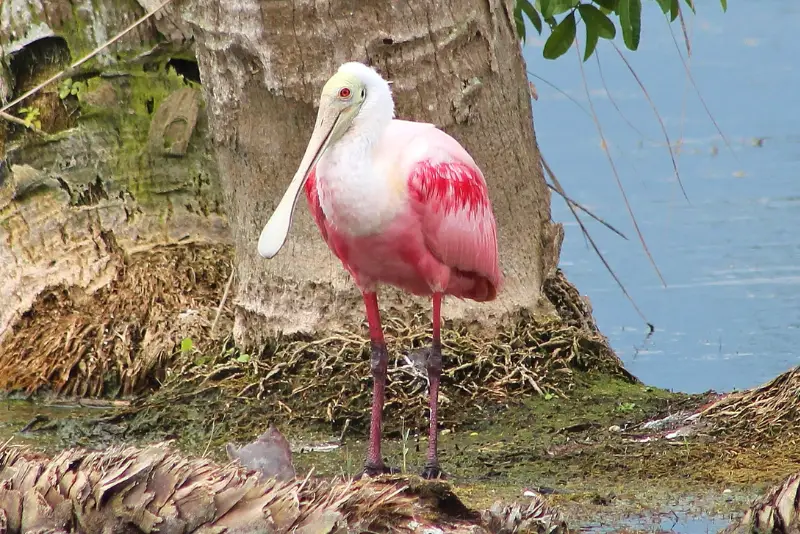
Roseate spoonbills are medium-sized wading birds in Florida, similar to storks but smaller, and can be readily recognized by their long spatula-shaped beaks.
Adults are white on their backs, neck, and face, while the rest of their plumage is bright pink. However, it should be noted that the exact shade of pink can vary a lot, depending on its diet.
The more shrimp it eats, the more pink its plumage becomes, due to the carotenoid substances found in shrimp.
These pink Florida birds are sometimes mistaken for flamingos because they look superficially similar, but keen ornithologists will notice that flamingos have a short, angled bill, while spoonbills have a long, spatulate bill that has a broad “spoon” at its end.
The best place to see these gorgeous birds in Florida is in the Everglades, which has more than 200 breeding pairs.
Great Egret
Scientific name: Ardea alba
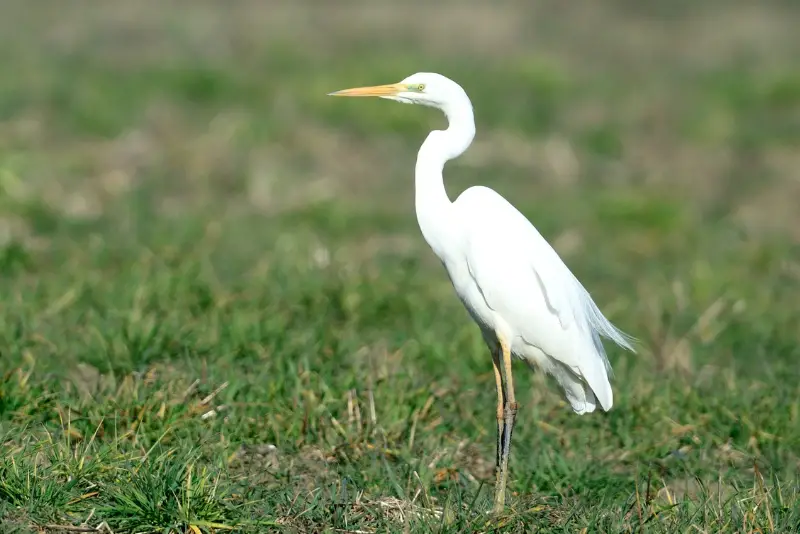
The Great Egret has a range that spans nearly the whole planet, and can be found on almost all continents.
These white birds in Florida have long necks and legs, as well as a long, yellow beak.
During the spring and summer breeding seasons, the Great Egret grows a plume on its back that extends all the way to the tip of its tail.
It lives in both saltwater and freshwater habitats, and often nests in large colonies on the shores of marshes, lakes, and rivers.
Great Egrets forage in any type of shallow water, including ponds, lakes, rivers, estuaries, as well as rice fields and other flooded areas in Florida.
It is especially prevalent in the eastern and central regions of Florida throughout the summer.
Outside of the breeding season it is less common, but where it occurs it can be seen in large flocks.
Snowy Egret
Scientific name: Egretta thula
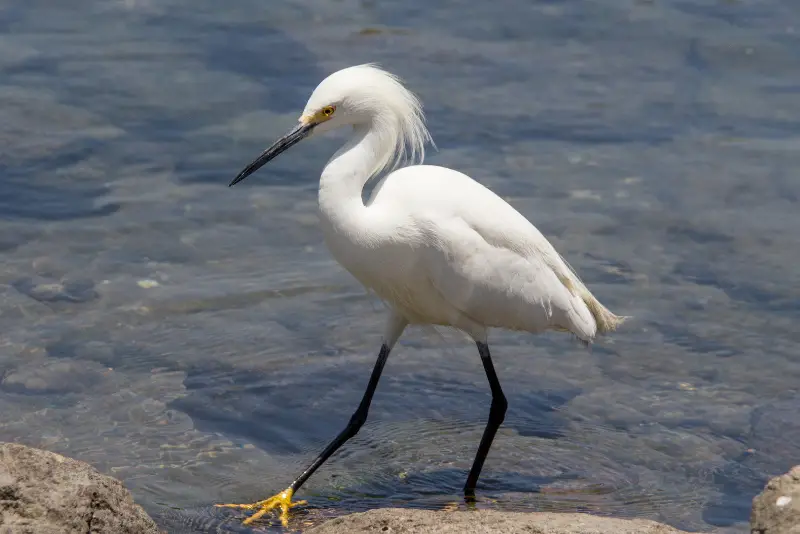
The Snowy Egret has become an increasingly common breeding bird all over Florida.
This is due to aggressive conservation efforts that were necessary because this Egret species was systematically hunted in previous centuries.
This little white Florida heron stands out due to its slim black bill and bright area between the eyes and nostrils.
In adult birds, the feet are a brilliant golden yellow, while the legs are totally black. It is thought that the brightly colored feet help to attract small fish and other prey.
The legs of juvenile birds have a predominant greenish yellow color, with some black areas on the front of the leg.
It is found in practically all types of wetland environments, from small ponds to saltwater and everything in between.
During the summer, the Snowy Egret is a rare to relatively common breeding bird in Florida.
It is much more common during the winter months, when large numbers can be observed in the coastal areas of Florida.
Great Blue Heron
Scientific name: Ardea herodias
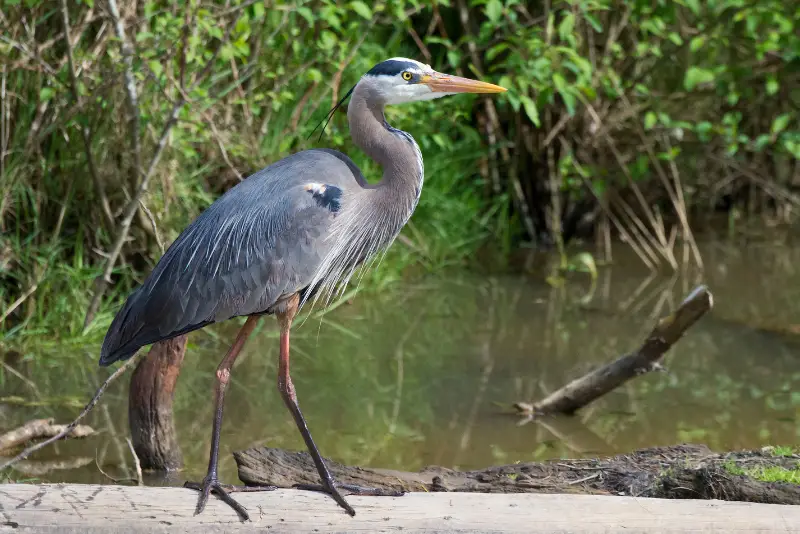
The Great Blue Heron is one of the most common herons found in Florida, where it can be seen year round.
With a wingspan of up to 6 feet, this heron is almost entirely blue gray, except for a white throat and eye stripe, as well as dark gray wing feathers.
This enormous bird likes to hunt for small mammals and fish by wading in the shallows of estuaries, mud flats and marshes along the seaboard.
Great Blue Herons can be found in many wetland habitats. You can find them in both saltwater and freshwater marshes, flooded fields, mangrove swamps, and lake shorelines.
This heron spends a lot of time standing motionless in shallow water, where it waits patiently for a suitably sized fish to come close enough to be grabbed with its long, yellow bill.
Little Blue Heron
Scientific name: Egretta caerulea
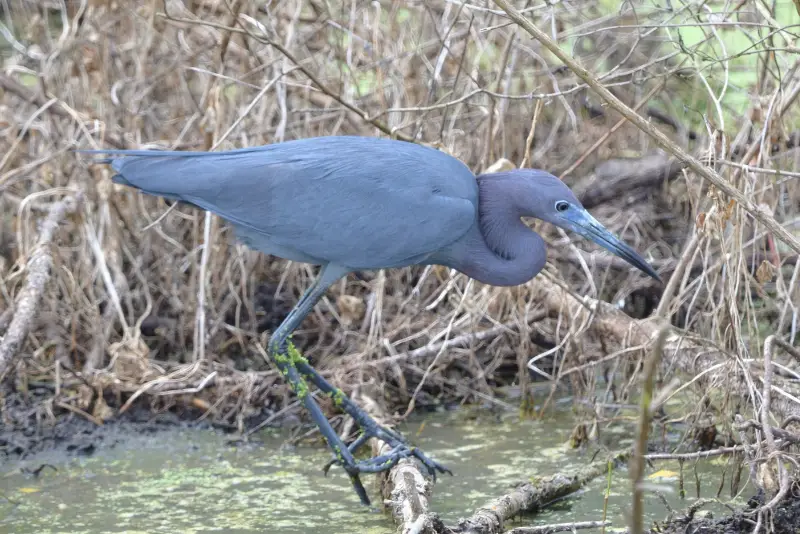
While adult Little Blue Herons are slate blue, young birds are entirely white during their first year.
Juvenile Little Blue Herons can be distinguished from other white herons by their dark bill and green legs.
These small herons are common breeding birds of Florida that can be seen year-round.
During winter, their numbers swell, due to an influx of birds from further north, which spend the winter months in Florida.
These herons feed on small fish, mollusks and crustaceans, with crayfish forming a large part of their diet.
They prefer aquatic habitats, where these birds hunt in the shallows, and they are rarely seen away from water.
Little Blue Herons build their nests out of sticks and in colonies. The female lays 4 to 6 eggs, and both parents take turns incubating the eggs for up to 25 days.
Tricolored Heron
Scientific name: Egretta tricolor
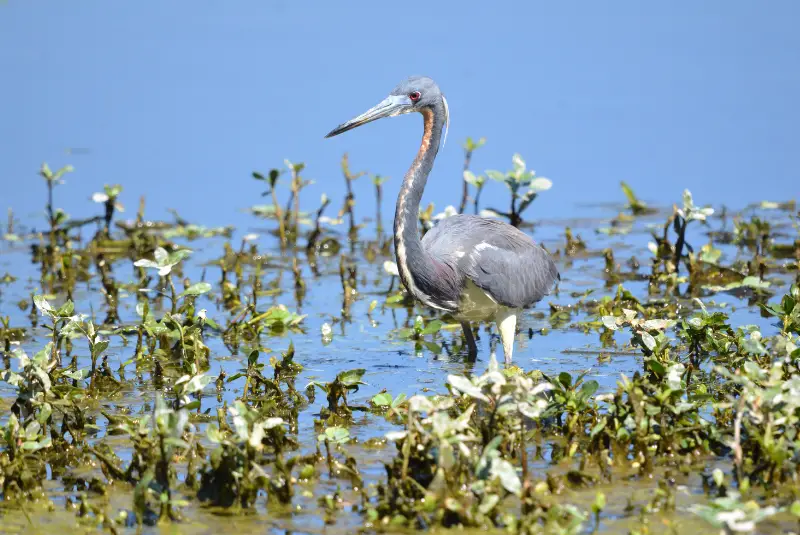
The Tricolored Heron used to be called the Louisiana Heron, and is a medium-sized wading bird with a blue-gray upper side and chest, as well as a white belly.
It is a regular breeding bird in Florida, where it is most often found in estuaries and salt water marshes along the Gulf Coast.
While Tricolored Herons like to nest in colonies, sometimes forming colonies with other heron species, they often forage alone and are fiercely protective of their territory.
They consume fish, crustaceans, amphibians, and insects, and will drive away other wading birds that invade their habitat.
This Florida shorebird hunts in shallow waters, usually by patiently waiting until its prey comes within reach.
Wood Stork
Scientific name: Mycteria americana
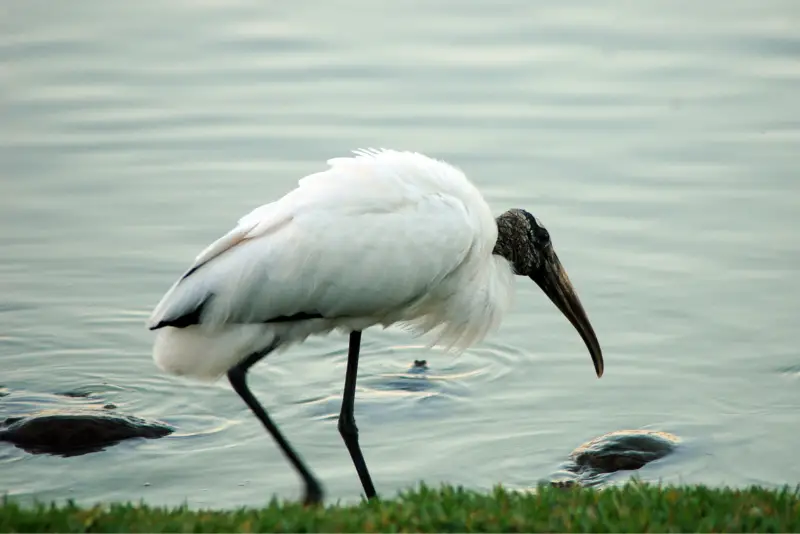
It’s easy to identify a Wood Stork if you can see it up close, due to its entirely white body combined with a bald, black head.
Similar to the White Ibis, the Wood Stork has a bill that curves slightly downwards. However, in contrast to the White Ibis, the Wood Stork has a black bill.
While the tail and wing tips are black, this is usually only apparent when you see a Wood Stork in flight.
The Wood Stork is a large bird, similar in size to a Great Egret, but is easily distinguishable from that species by its curved beak.
Unfortunately, Wood Stork populations have been in decline over the past decades, which is a trend that it shares with many other wading birds.
It feeds on frogs and other amphibians, fish, and aquatic invertebrates. It likes to nest in large colonies in old trees close to foraging areas.
Whooping Crane
Scientific name: Grus americana
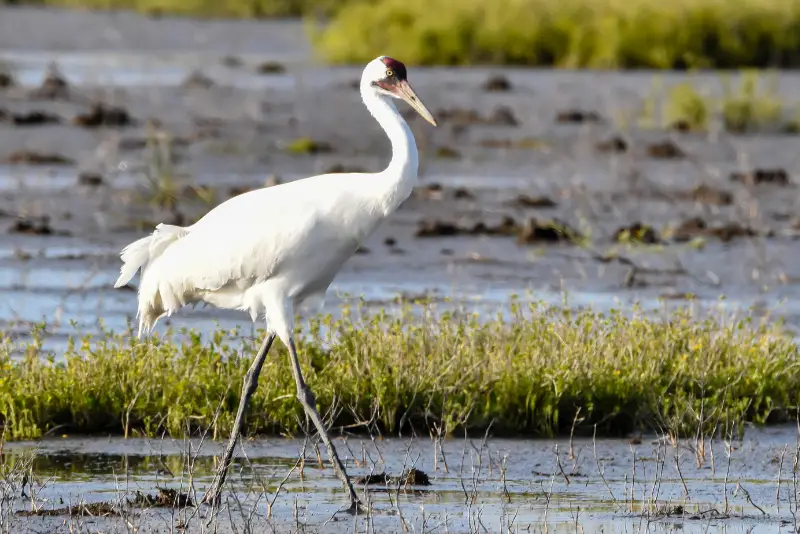
The Whooping Crane was almost at the edge of extinction in the 1930s, with less than 20 birds remaining.
However, sustained conservation efforts have brought it back to a current population that numbers 600 birds.
Adult Whooping Cranes have a completely white body, with a red cap that consists of bare skin. In contrast to adults, juvenile birds have a reddish brown color.
Whooping Cranes are only found in Florida during the cold season, wintering in the Sunshine State. They breed in Alberta, Canada, and migrate long distances south to spend the winter.
During the non-breeding season, the preferred habitat of Whooping Cranes are marshes, estuaries, and salt flats.
These birds feed mainly on crustaceans and mollusks, with blue crabs making up the largest part of their diet.
While the population of Whooping Cranes has made an amazing comeback from the edge of extinction, it is still a critically endangered species, and in need of continued conservation efforts.
American White Pelican
Scientific name: Pelecanus erythrorhynchos

The American White Pelican is one of the largest birds in Florida, and is almost entirely white, except for black primary and secondary feathers on its wings.
Its huge beak is bright orange, and has a flat plate protruding from the upper part of the beak during the summer breeding season.
Outside of the breeding season, the bill changes its color from orange to pale yellowish.
American White Pelicans are most often observed in Florida during the winter months, as these birds are winter visitors to the coastal areas of Florida.
Its preferred habitat are estuaries, shallow bays, and coastal inlets, as well as freshwater lakes further inland.
This Florida bird feeds almost exclusively on fish, but unlike other pelican species it doesn’t dive in order to catch them. Instead it submerges its head down into the water, and grabs fish with its large beak.
These large white birds are most often seen in groups that like to cooperate with each other when foraging for fish.
Brown Pelican
Scientific name: Pelecanus occidentalis

The Brown Pelican is a common sight along the Florida seashore, where it hunts fish by plunging head-first into the water.
Adult Brown Pelicans are grayish brown with a dark belly, and can be easily recognized by their massive bill.
While this pelican species was endangered a few decades ago due to pesticide poisoning, it has now recovered and is once more a common breeding bird and year-round resident in Florida.
Black Skimmer
Scientific name: Rynchops niger
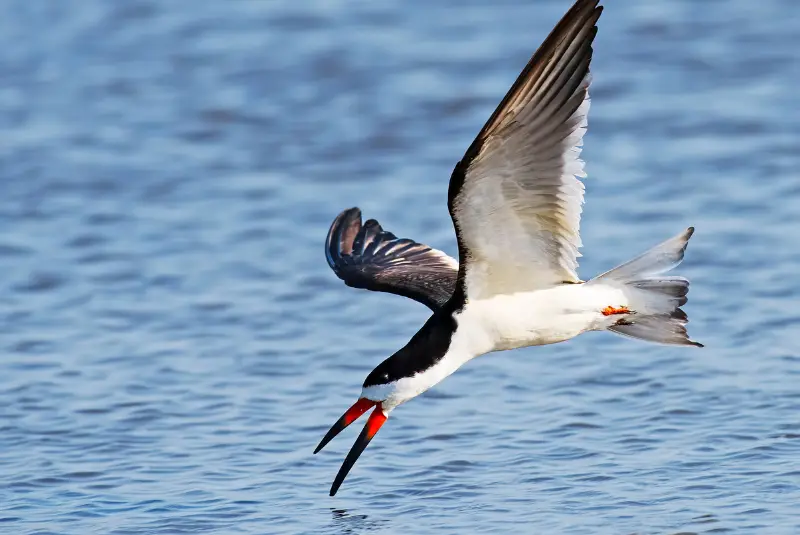
The Black Skimmer is a striking coastal bird that is easy to identify both by its appearance and its behavior.
The black upperside contrasts with a bright white underside, and with a long red bill. The lower part of the bill is significantly longer than the upper part.
It catches fish by flying along the water surface, while pulling its lower bill through the water. When the lower bill encounters a fish, the bill slams shut to catch its prey.
The Black Skimmer breeds along the Florida Gulf Coast and the Florida East Coast, and also occurs as a winter visitor in more southern areas of Florida.
Ruby-throated Hummingbird
Scientific name: Archilochus colubris
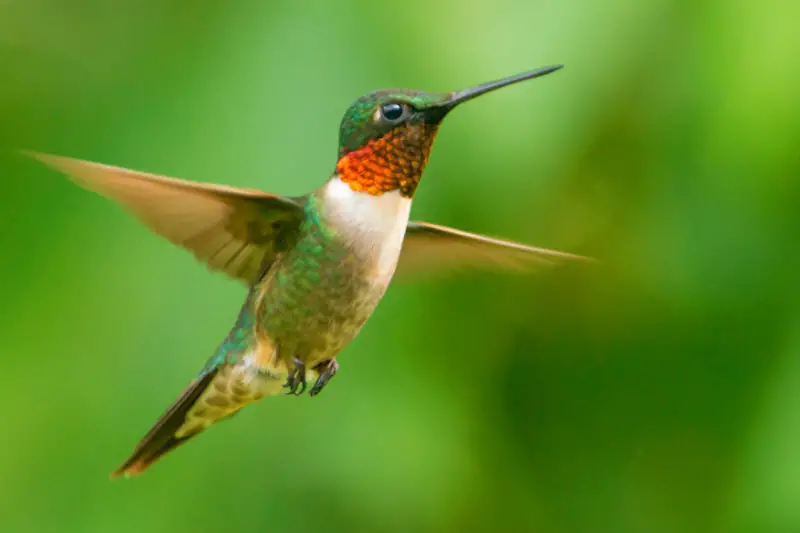
The Ruby-throated Hummingbird is one of the smallest birds in Florida. Weighing just 0.1 ounces, it is truly a tiny songbird compared to other species.
The male has a black throat that reflects flashes of ruby red when it catches the sunlight, and a long, thin beak that it uses to drink nectar from flowers.
This Florida hummingbird is attracted to gardens and backyards that have tubular flowers that produce a lot of nectar.
In addition to flower nectar, this diminutive bird also feeds on insects. It is a long-distance migrant, and spends its winter in Central America.
Final remarks
In summary, here are the 21 types of Florida birds that have long beaks:
- White Ibis
- Limpkin
- Long-billed Dowitcher
- Long-billed Curlew
- Black-necked Stilt
- Willet
- Whimbrel
- American Oystercatcher
- American Avocet
- Roseate Spoonbill
- Great Egret
- Snowy Egret
- Great Blue Heron
- Little Blue Heron
- Tricolored Heron
- Wood Stork
- Whooping Crane
- American White Pelican
- Brown Pelican
- Black Skimmer
- Ruby-throated Hummingbird
If you’ve spotted one of these birds while bird watching in Florida, but aren’t sure which species of bird it was, check our detailed ID guide with photos above.
If you enjoyed this article, check out our guide to the birds of prey in Florida.

